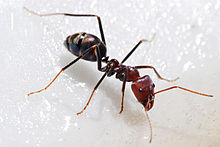
Back ايريدوميرمكس ARZ Iridomyrmex Catalan Iridomyrmex CEB Iridomyrmex German Iridomyrmex Spanish مورچههای رنگینکمانی Persian Iridomyrmex French Iridomyrmex ID Iridomyrmex Georgian 흰발마디개미속 Korean
| Iridomyrmex Temporal range: Eocene to present
| |
|---|---|

| |
| Meat ant (I. purpureus) | |
| Scientific classification | |
| Domain: | Eukaryota |
| Kingdom: | Animalia |
| Phylum: | Arthropoda |
| Class: | Insecta |
| Order: | Hymenoptera |
| Family: | Formicidae |
| Subfamily: | Dolichoderinae |
| Tribe: | Leptomyrmecini |
| Genus: | Iridomyrmex Mayr, 1862[1] |
| Type species | |
| Formica detecta Smith, 1858
| |
| Diversity[2] | |
| c. 79 extant species 5 fossil species | |
Iridomyrmex is a genus of ants called rainbow ants (referring to their blue-green iridescent sheen) first described by Austrian entomologist Gustav Mayr in 1862. He placed the genus in the subfamily Dolichoderinae of the family Formicidae. It has 79 described species and five fossil species. Most of these ants are native to Australia; others are found in Asia and Oceania, and they have been introduced to Brazil, New Zealand, and the United Arab Emirates. Fossil species are known from China, France, and the United States.
These ants are known to be an ecologically dominant and important group of ants, but they are sometimes regarded as pests because they disturb soil and enter human houses. Farmers in rural Australia place animal carcasses on meat ant (I. purpureus) mounds as a method of disposing of them; meat ants consume the carcass and reduce it to bones in a matter of weeks. Meat ants also engage in ritualised fighting, which helps prevent casualties and solve territorial disputes between neighbouring colonies. The largest members of this genus are those of the I. purpureus species group, measuring 8 mm (0.31 in).
After their nuptial flight, queen ants may establish a colony by themselves, by budding, or cooperatively, where a subset of the colony migrates to a new location or when multiple queens help find a suitable nesting spot, but they display intolerance to each other when workers are present. The eggs take 44 to 61 days to fully develop into adults. Ants of the genus live in a wide variety of habitats and nest in soil in numbers that range from a few hundred individuals to over 300,000 in a single colony. Depending on the species, nests are large mounds covered in pebbles with multiple entrances, while others live above ground in twig nests. In some cases, ants dwell in several nest sites connected by paths; some of these nests can extend to 650 m (2,130 ft) in length. Some species associate with caterpillars and butterflies that provide the ants with secretions and honeydew, and I. bicknelli pollinates orchids. These ants are predators and scavengers; they hunt for prey to feed their young. Notably, these ants are immune to the toxins of the cane toad and feed on the juveniles. Predators such as spiders, birds, lizards, and other ants prey on Iridomyrmex ants.
- ^ Johnson, Norman F. (19 December 2007). "Iridomyrmex Mayr". Hymenoptera Name Server version 1.5. Columbus, Ohio, USA: Ohio State University. Archived from the original on 11 June 2015. Retrieved 11 June 2015.
- ^ Bolton, B. (2014). "Iridomyrmex". AntCat. Retrieved 18 August 2014.
© MMXXIII Rich X Search. We shall prevail. All rights reserved. Rich X Search